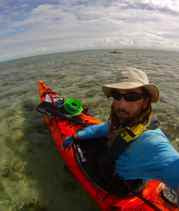Over the last few days we have left the safety of the coastline and the more obvious islands and headed further out to sea. This has been partly fuelled by our desire to find a patch of ocean that is not crawling with crocodiles so that we can give our snorkels a bit of a workout. And wow, has it been worth it.
A highly trained troupe of Chinese contortionists would be proud of the way Lain and I twist and squeeze into our boats every day. Inside the cockpit we have several water containers (like large wine casks in a tough bag), a water bladder with a tube, a pair of sandles, an extra seat and a few other bits, all tied in with bungee cords. Then we wear a spray deck, a life jacket, hat, sunnies, gloves and we are always clipped in to a survival kit. You can perhaps imagine the gymnastics required to jiggle out of all this clobber while attempting not to capsize or fill the cockpit with water. It is no easy feat.
Life under the waves, though, is always worth a look, especially when we are bobbing over part of the largest reef system on the planet. There are turtles, sharks and clownfish, the celebrities of the reef ecosystem, and then there are the hordes of other fish and creatures with names that only get marine biologists excited. Corals crowd around in all combinations of shape, size and colour - brilliant blues, iridescent green and golden yellows. Huge giant clams are speckled in thousands of tiny spots the brilliance of which no words could describe.
Kayaks have the unique ability to go where other boats can't, and paddlers therefore are privileged to see parts of the ocean even the most intrepid sailor cannot. To glide over a reef is incredible. No land is visible. Waves steepen a little as the first deep bommies appear beneath you, then they are all around. You can see the shapes, huge blobby lumps, flat plates, spiky branches, all dropping away into the deep. They are everywhere, getting thicker, shallower, joining up. The bommies become a constant plain of coral and rubble and you float over thousands of fish as you silently survey their world. Shallower now, only a couple of feet - turtle territory. Every 20 or 30m a huge frothing splash erupts from under your kayak as a terrified turtle bursts from its hideout in a flurry of flippers, desperate to escape to deeper water. Then the reef peters out and the desert begins.
From the comfort of your computer and with the knowledge you can glean from Google Earth you might assume that these vast reef systems are complex reef all the way through. I'm sure any self respecting marine biologist will tell you the same. However, behind the wall of bommies and the homes of the turtles lies an entirely different ecosystem. Thousands upon thousands of acres of shallow sand, only several kayak-scraping inches deep, are punctuated by the odd clump of algae, the slicing fins of a black-tip reef shark and the unmistakable, black, gooey and somewhat turd-like form of the sea cucumber, beeche-de-mere. Just like any desert there is obviously life in the sand, the thousands of small holes are clearly a great spot to live for some filter-feeding worm or a well-hidden mollusc.
This reef desert continues for sometimes kilometres, a peaceful respite from the waves, before gradually deepening, to a deep turquoise sea again, sometimes with a reverse of the battle lines drawn by the turtles, coral and their marauding armies of fish.
Reefs are a gentle place for the kayaker, a place to reflect. It is worth reflecting though, on just how far one might have to drag one's kayak should the falling tide drop too low and literally leave you stranded in the desert until the next high tide.


We are amazed by the progress you are making - and by your accounts of the wonders that each day brings. Hard to imagine quite where you are - and if you have stopped overnight on land or water. The satellite tracking is brilliant - and the beard is progressing well! Brit says that a very good friend, David Glasheen, lives on Restoration Island (about 20ks north of Lockyer River) if you need to call in there. Clearly we needn't worry about your diet ...red emperor, mud crabs and all! Take care.
ReplyDelete